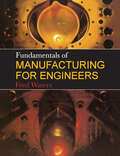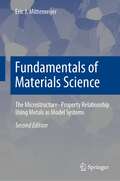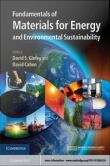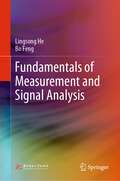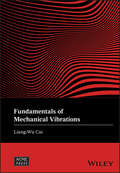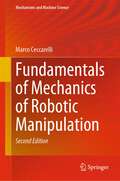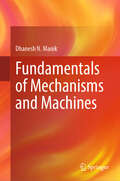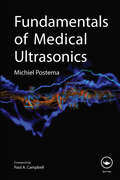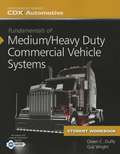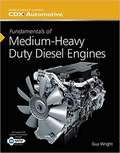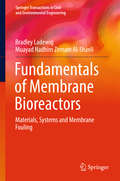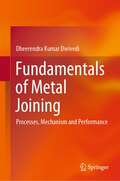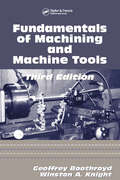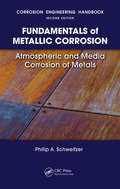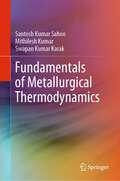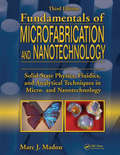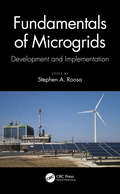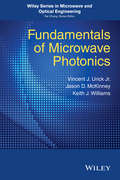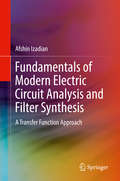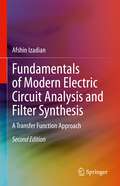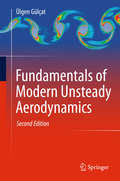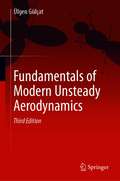- Table View
- List View
Fundamentals of Manufacturing For Engineers
by T F WatersThis textbook will be welcomed throughout engineering education as the one-stop teaching text for students of manufacturing. It takes the student through the fundamental principles and practices of modern manufacturing processes in a lively and informative fashion. Topics include casting, joining, cutting, metal deformation processes, surface treat
Fundamentals of Marine Riser Mechanics: Basic Principles and Simplified Analyses
by Charles SparksMarine risers are unusual structures that defy standard engineering intuition, yet they are critical to the safety and structural integrity of offshore platforms. In this new edition of Fundamentals of Marine Riser Mechanics, the six new chapters, which have been added to the original fifteen, provide further arguments to support effective tension as well as original analysis of helical buckling. Analytical methods are used to model all phases of the development of helical buckling within a riser, associated with flexing of the pipe within the seabed BOP and down hole. An entire chapter is devoted to the Macondo accident of 2010. Features and benefits of the new chapters and appendices included in the 2nd Edition: Further arguments that confirm the validity of the Effective Tension concept, based on analysis of real forces applied to the pipe walls by internal and external pressures Analysis of helically buckled pipes within casings, leading to exact expressions for all forces acting in and on a regular helix Analysis of helix end sections that connect a regular helix to a centralised end point on the casing axis, taking into account applied end moments (restoring or disturbing). Proof that such end sections must always include a transition section, in contact with the casing wall, linking the regular helix to the section out of contact with the casing wall. Analysis of drill-pipe deflection inside a seabed BOP and down hole, associated with helical buckling within a riser, with particular reference to the Macondo accident scenario. Discussion of how and when planar buckling transforms into helical buckling Appendices giving details of all required calculation methods Three new Excel files, added to the original seventeen, to allow readers to perform further calculations with their own data
Fundamentals of Massive MIMO
by Hong Yang Thomas L. Marzetta Erik G. Larsson Hien Quoc NgoWritten by pioneers of the concept, this is the first complete guide to the physical and engineering principles of Massive MIMO. Assuming only a basic background in communications and statistical signal processing, it will guide readers through key topics such as propagation models, channel modeling, and multi-cell performance analyses. The authors' unique capacity-bound approach will enable readers to carry out more effective system performance analysis and develop advanced Massive MIMO techniques and algorithms. Numerous case studies, as well as problem sets and solutions accompanying the book online, will help readers put knowledge into practice and acquire the skillset needed to design and analyze complex wireless communication systems. Whether you are a graduate student, researcher, or industry professional working in the field of wireless communications, this will be an indispensable guide for years to come.
Fundamentals of Materials Science: The Microstructure–Property Relationship Using Metals as Model Systems (Graduate Texts In Physics Ser.)
by Eric J. MittemeijerThis textbook offers a strong introduction to the fundamental concepts of materials science. It conveys the quintessence of this interdisciplinary field, distinguishing it from merely solid-state physics and solid-state chemistry, using metals as model systems to elucidate the relation between microstructure and materials properties.Mittemeijer's Fundamentals of Materials Science provides a consistent treatment of the subject matter with a special focus on the microstructure-property relationship. Richly illustrated and thoroughly referenced, it is the ideal adoption for an entire undergraduate, and even graduate, course of study in materials science and engineering. It delivers a solid background against which more specialized texts can be studied, covering the necessary breadth of key topics such as crystallography, structure defects, phase equilibria and transformations, diffusion and kinetics, and mechanical properties. The success of the first edition has led to this updated and extended second edition, featuring detailed discussion of electron microscopy, supermicroscopy and diffraction methods, an extended treatment of diffusion in solids, and a separate chapter on phase transformation kinetics.“In a lucid and masterly manner, the ways in which the microstructure can affect a host of basic phenomena in metals are described.... By consistently staying with the postulated topic of the microstructure - property relationship, this book occupies a singular position within the broad spectrum of comparable materials science literature .... it will also be of permanent value as a reference book for background refreshing, not least because of its unique annotated intermezzi; an ambitious, remarkable work.” G. Petzow in International Journal of Materials Research. “The biggest strength of the book is the discussion of the structure-property relationships, which the author has accomplished admirably.... In a nutshell, the book should not be looked at as a quick ‘cook book’ type text, but as a serious, critical treatise for some significant time to come.” G.S. Upadhyaya in Science of Sintering. “The role of lattice defects in deformation processes is clearly illustrated using excellent diagrams . Included are many footnotes, ‘Intermezzos’, ‘Epilogues’ and asides within the text from the author’s experience. This ..... soon becomes valued for the interesting insights into the subject and shows the human side of its history. Overall this book provides a refreshing treatment of this important subject and should prove a useful addition to the existing text books available to undergraduate and graduate students and researchers in the field of materials science.” M. Davies in Materials World.
Fundamentals of Materials for Energy and Environmental Sustainability
by David Cahen David S. GinleyHow will we meet rising energy demands? What are our options? Are there viable long-term solutions for the future? Learn the fundamental physical, chemical and materials science at the heart of: * Renewable/non-renewable energy sources * Future transportation systems * Energy efficiency * Energy storage Whether you are a student taking an energy course or a newcomer to the field, this book will help you understand critical relationships between the environment, energy and sustainability. Leading experts provide comprehensive coverage of each topic, bringing together diverse subject matter by integrating theory with engaging insights. Each chapter includes helpful features to aid understanding, including a historical overview to provide context, suggested further reading and questions for discussion. Every subject is beautifully illustrated and brought to life with full color images and color-coded sections for easy browsing, making this a complete educational package. Fundamentals of Materials for Energy and Environmental Sustainability will enable today's scientists and educate future generations.
Fundamentals of Measurement and Signal Analysis
by Lingsong He Bo FengThis book introduces the basic analysis methods in signal processing, principles of various sensors and the concept of measurement system. To make students better understand and apply the theories, the book includes many MATLAB examples, such as the generation of standard signals and the spectrum analysis of audio signals in the signal processing part and Arduino examples as well, such as temperature measuring and ultrasonic ranging to show the applications of sensors. Readers can not only learn the fundamental theories but also get many opportunities to apply the theories to perform measurement tasks.
Fundamentals of Mechanical Vibrations
by Liang-Wu CaiThis introductory book covers the most fundamental aspects of vibration analysis for mechanical engineers. Vibration studies small motions of a mechanical system around its equilibrium configuration. The book consists of five major topics, each in its own chapter. It starts from a concise introduction to Langrangian dynamics as a tool for obtaining the governing equation(s) of motion for a system. In the process, key concepts such as degrees of freedom are rigorously defined. The second topic introduces mathematical tools for different types of vibration analyses for single degree-of-freedom systems. In the process, mathematical software Matlab is used to explore every example in a symbolic way, and in a curiosity-driven manner. The third topic introduces the lumped-parameter modelling process: how to convert many simple engineering structures into models consisting of masses and springs so that the multiple degrees of freedom systems, with many examples suitable for hand calculations and a few computer-aided examples that bridges the lumped-parameter models and continuous systems. The last topic introduces the finite element method. It is formally introduced by following the framework of Lagrangian dynamics, and followed by examples of vibration analyses using a commercial software package.
Fundamentals of Mechanics of Robotic Manipulation (Mechanisms and Machine Science #112)
by Marco CeccarelliThe book explores the fundamental issues of robot mechanics for both the analysis and design of manipulations, manipulators and grippers, taking into account a central role of mechanics and mechanical structures in the development and use of robotic systems with mechatronic design. It examines manipulations that can be performed by robotic manipulators. The contents of the book are kept at a fairly practical level with the aim to teach how to model, simulate, and operate robotic mechanical systems. The chapters have been written and organized in a way that they can be red even separately, so that they can be used separately for different courses and purposes. The introduction illustrates motivations and historical developments of robotic mechanical systems. Chapter 2 describes the analysis and design of manipulations by automatic machinery and robots; chapter 3 deals with the mechanics of serial-chain manipulators with the aim to propose algorithms for analysis, simulation, and design purposes; chapter 4 introduces the mechanics of parallel manipulators; chapter 5 addresses the attention to mechanical grippers and related mechanics of grasping.
Fundamentals of Mechanisms and Machines
by Dhanesh N. ManikThis book is all about mechanisms and machines, one of the most important core subjects of mechanical engineering. There are many ways a mechanism can be configured and there are many mechanisms in a machine, creating a tremendous opportunity to build better machines of our choice. To do so, however, one needs to understand the common thread present in the thousands of configurations and to break them down into a set of rules. This book does exactly that, using the same set of rules consistently to explain the design of any mechanism or machine. Pedagogical tools and approaches have been utilized to make it easier and more interesting for the student- extensive illustrations, simple explanations and exercise problems with useful hints have been included. The systematic use of a vector-based approach makes learning easier and helps extend the knowledge acquired in this book to applications in robotics.
Fundamentals of Medical Ultrasonics
by Michiel PostemaUltrasonic imaging is an economic, reliable diagnostic technique. Owing to recent therapeutic applications, understanding the physical principles of medical ultrasonics is becoming increasingly important. Covering the basics of elasticity, linear acoustics, wave propagation, nonlinear acoustics, transducer components, ultrasonic imaging modes, basi
Fundamentals of Medium/Heavy Duty Commercial Vehicle Systems: Student Workbook
by Cdx AutomotiveThis Student Workbook contains exercises to reinforce what you will learn in both Fundamentals of Medium/Heavy Duty Commercial Vehicle Systems and the classroom. The Student Workbook is designed to encourage critical thinking and aid comprehension through a variety of exercises in each chapter, including: <P><P>ASE-Type Questions - Test your critical thinking skills and prepare for certification exams. <P><P>Skill Drill Activities - Test your skills with photo jumbles and caption fill-ins. Place photos in the correct order to test your knowledge of a skill and fill-in the captions to ensure that you know all the details of each step. <P><P>Labeling - Master visual recognition with labeling activities that test your knowledge of automotive tools, parts, and systems. <P><P>And More- Matching, multiple choice, true/false, fill-in-the-blank, and crossword puzzles.
Fundamentals of Medium/Heavy Duty Diesel Engines
by Cdx Automotive Staff Gus WrightBased on the 2014 National Automotive Technicians Education Foundation (NATEF) Medium/Heavy Truck Tasks Lists and ASE Certification Test Series for truck and bus specialists, Fundamentals of Medium/Heavy Duty Diesel Engines is designed to address these and other international training standards. The text offers comprehensive coverage of every NATEF task with clarity and precision in a concise format that ensures student comprehension and encourages critical thinking. <p><p> Fundamentals of Medium/Heavy Duty Diesel Engines describes safe and effective diagnostic, repair, and maintenance procedures for today’s medium and heavy vehicle diesel engines, including the most current, relevant, and practical coverage of: • HD-OBD emission diagnostics • Common rail injection systems • Exhaust after treatment systems, including diesel particulate filters, selective catalyst reduction (SCR), and lean NOx traps (LNT) • Variable geometry and series turbocharging • Exhaust gas recirculation • Engine braking • Major engine OEM-specific coverage of fuel, air induction, and diagnostic systems • Electronic signal processing and sensor technology Additional features include: • Up-to-date NATEF coverage • Support of ASE certification test preparation for diesel engine, medium-heavy truck, and bus test series • A clear, accessible writing style • Reinforcement of concepts learned • Application to real-world practice • A wealth of photographs, illustrations, and step-by-step explanations with visual summaries
Fundamentals of Membrane Bioreactors
by Bradley Ladewig Muayad Nadhim Zemam Al-ShaeliThis book provides a critical, carefully researched, up-to-date summary of membranes for membrane bioreactors. It presents a comprehensive and self-contained outline of the fundamentals of membrane bioreactors, especially their relevance as an advanced water treatment technology. This outline helps to bring the technology to the readers' attention, and positions the critical topic of membrane fouling as one of the key impediments to its more widescale adoption. The target readership includes researchers and industrial practitioners with an interest in membrane bioreactors.
Fundamentals of Metal Joining: Processes, Mechanism and Performance
by Dheerendra Kumar DwivediThis textbook provides fundamental understanding on technological aspects related to arc welding, heat flow, relevant metallurgical transformations, and quality assurance methodologies joints. It has been composed keeping in purview the requirements of those interested in research and development in the field of metal joining. The contents focus on the fundamentals of physics of welded joints, arc welding processes, brazing and soldering, heat flow in welding, welding metallurgy, design of welded joints, and inspection and testing of welded joints and weldability of metals. This book will be useful to both academics and those in the industry.
Fundamentals of Metal Machining and Machine Tools
by Geoffrey Boothroyd Winston A. KnightReflecting changes in machining practice, Fundamentals of Machining and Machine Tools, Third Edition emphasizes the economics of machining processes and design for machining. This edition includes new material on super-hard cutting tool materials, tool geometries, and surface coatings. It describes recent developments in high-speed machining, hard machining, and cutting fluid applications such as dry and minimum-quantity lubrication machining. It also presents analytical methods that outline the limitations of various approaches. This edition features expanded information on tool geometries for chip breaking and control as well as improvements in cost modeling of machining processes.
Fundamentals of Metallic Corrosion: Atmospheric and Media Corrosion of Metals (Corrosion Engineering Handbook, Second Edition)
by P.E., Philip SchweitzerUnderstanding corrosion is essential for selecting and maintaining equipment and structural components that will withstand environmental and process conditions effectively. Fundamentals of Metallic Corrosion: Atmospheric and Media Corrosion of Metals focuses on the mechanisms of corrosion as well as the action of various corrodents on metals and th
Fundamentals of Metallurgical Thermodynamics
by Mithilesh Kumar Santosh Kumar Sahoo Swapan Kumar KarakThis book highlights introduction of thermodynamics; first law, second law, third law of thermodynamics and their applications; concepts of entropy, free energies, thermodynamic equilibrium, thermodynamic activity and fugacity; Maxwell relations; Gibbs-Helmholtz equation; Clausis-Clayperon equation, etc. have been discussed in detail and made easily understandable to the undergraduate students of metallurgy. Thermodynamics involved in formation of different types of solutions (ideal, real and regular solutions) has also been discussed in detail. This book also discusses the applications of various thermodynamic properties in different metallurgical operations. At the end of each and every chapter, different types of typical related problems have also been solved.
Fundamentals of Microfabrication and Nanotechnology, Three-Volume Set
by Marc J. MadouNow in its third edition, Fundamentals of Microfabrication and Nanotechnology continues to provide the most complete MEMS coverage available. Thoroughly revised and updated the new edition of this perennial bestseller has been expanded to three volumes, reflecting the substantial growth of this field. It includes a wealth of theoretical and practical information on nanotechnology and NEMS and offers background and comprehensive information on materials, processes, and manufacturing options. The first volume offers a rigorous theoretical treatment of micro- and nanosciences, and includes sections on solid-state physics, quantum mechanics, crystallography, and fluidics. The second volume presents a very large set of manufacturing techniques for micro- and nanofabrication and covers different forms of lithography, material removal processes, and additive technologies. The third volume focuses on manufacturing techniques and applications of Bio-MEMS and Bio-NEMS. Illustrated in color throughout, this seminal work is a cogent instructional text, providing classroom and self-learners with worked-out examples and end-of-chapter problems. The author characterizes and defines major research areas and illustrates them with examples pulled from the most recent literature and from his own work.
Fundamentals of Microgrids: Development and Implementation
by Stephen A. RoosaMicrogrids provide opportunities to develop new electrical networks targeted for the needs of communities. The fourth industrial revolution is associated with the global trend toward decentralizing energy grids. Within this context, microgrids are seen as a solution to how renewable electricity can be supplied to local areas. The Fundamentals of Microgrids: Development and Implementation provides an in-depth examination of microgrid energy sources, applications, technologies, and policies. This book considers the fundamental configurations and applications for microgrids and examines their use as a means of meeting international sustainability goals. It focuses on questions and issues associated with microgrid topologies, development, implementation and regulatory issues. Distributed energy resources are defined, stand-a-lone generation systems are described and examples of typical microgrid configurations are provided. The key components of developing a business model for microgrid development are also considered. Features: Describes what microgrids are and details the basics of how they work while considering benefits of microgrids and their disadvantages. Provides answers to the fundamental questions energy managers and other professionals want to know about the basics of microgrids. Details the applications for microgrids and demystifies the types of microgrid architectures that are successful. Includes real-world examples of functioning microgrids which provide models for the development of microgrids in the future. Discusses the key considerations that must be addressed to develop a business case for microgrid development.
Fundamentals of Microwave Photonics
by Keith J. Williams Jason D. Mckinney V. J. UrickA comprehensive resource to designing and constructing analog photonic links capable of high RF performance Fundamentals of Microwave Photonics provides a comprehensive description of analog optical links from basic principles to applications. The book is organized into four parts. The first begins with a historical perspective of microwave photonics, listing the advantages of fiber optic links and delineating analog vs. digital links. The second section covers basic principles associated with microwave photonics in both the RF and optical domains. The third focuses on analog modulation formats--starting with a concept, deriving the RF performance metrics from basic physical models, and then analyzing issues specific to each format. The final part examines applications of microwave photonics, including analog receive-mode systems, high-power photodiodes applications, radio astronomy, and arbitrary waveform generation. Covers fundamental concepts including basic treatments of noise, sources of distortion and propagation effects Provides design equations in easy-to-use forms as quick reference Examines analog photonic link architectures along with their application to RF systems A thorough treatment of microwave photonics, Fundamentals of Microwave Photonics will be an essential resource in the laboratory, field, or during design meetings. The authors have more than 55 years of combined professional experience in microwave photonics and have published more than 250 associated works.
Fundamentals of Modern Electric Circuit Analysis and Filter Synthesis: A Transfer Function Approach
by Afshin IzadianThis textbook explains the fundamentals of electric circuits and uses the transfer function as a tool to analyze circuits, systems, and filters. The author avoids the Fourier transform and three phase circuits, since these topics are often not taught in circuits courses. General transfer functions for low pass, high pass, band pass and band reject filters are demonstrated, with first order and higher order filters explained in plain language. The author’s presentation is designed to be accessible to a broad audience, with the concepts of circuit analysis explained in basic language, reinforced by numerous, solved examples.
Fundamentals of Modern Electric Circuit Analysis and Filter Synthesis: A Transfer Function Approach
by Afshin IzadianThis textbook explains the fundamentals of electric circuits and uses the transfer function as a tool to analyze circuits, systems, and filters. The author avoids the Fourier transform, since this topic is often not taught in circuits courses. General transfer functions for low pass, high pass, band pass and band reject filters are demonstrated, with first order and higher order filters explained in plain language. The author’s presentation is designed to be accessible to a broad audience, with the concepts of circuit analysis explained in basic language, reinforced by numerous, solved examples.
Fundamentals of Modern Unsteady Aerodynamics
by Ülgen GülçatIn this textbook, the author introduces the concept of unsteady aerodynamics and its underlying principles. He provides the readers with a full review of fundamental physics of the free and the forced unsteadines, the terminology and basic equations of aerodynamics ranging from incompressible flow to hypersonics. The book also covers the modern topics concerning the developments made during the last years, especially in relation to wing flappings for propulsion. The book is written for graduate and senior year undergraduate students in Aerodynamics, and it serves as a reference for experienced researchers. Each chapter includes ample examples, questions, problems and relevant references.
Fundamentals of Modern Unsteady Aerodynamics
by Ülgen GülçatThis book introduces the concept of unsteady aerodynamics and its underlying principles. The author provides the readers with a comprehensive review of the fundamental physics of free and forced unsteadiness, the terminology and basic equations of aerodynamics ranging from incompressible flow to hypersonics. The book also covers modern topics related to the developments made in recent years, especially in relation to wing flapping for propulsion. The book is written for graduate and senior year undergraduate students in aerodynamics and also serves as a reference for experienced researchers. Each chapter includes ample examples, questions, problems and relevant references.This 3rd edition includes a new chapter about unsteady applications related to the thrust optimization, aerodynamic stability and trim because there has been much progress in unsteady applications of the flapping wing technology. In addition, further material is presented in Appendix for evaluating the stability derivatives so that no derivation of equations is left incomplete but not overdone in the text.
Fundamentals of Modern VLSI Devices
by Yuan Taur Tak H. NingThis book examines in detail the basic properties and design, including chip integration, of CMOS and bipolar VLSI devices and discusses the various factors that affect their performance. The authors begin with a thorough review of the relevant aspects of semiconductor physics, and proceed to a description of the design of CMOS and bipolar devices. The optimization of these devices for VLSI applications is also covered. The authors highlight the intricate interdependencies and subtle trade-offs between those device parameters, such as power consumption and packing density, that affect circuit performance and manufacturability. They also discuss in detail the scaling, and physical limits to the scaling, of CMOS and bipolar devices. The book contains many exercises, and can be used as a textbook for senior undergraduate or first-year graduate courses on microelectronics or VLSI devices. It will also be a valuable reference volume for practising engineers involved in research and development in the electronics industry.
